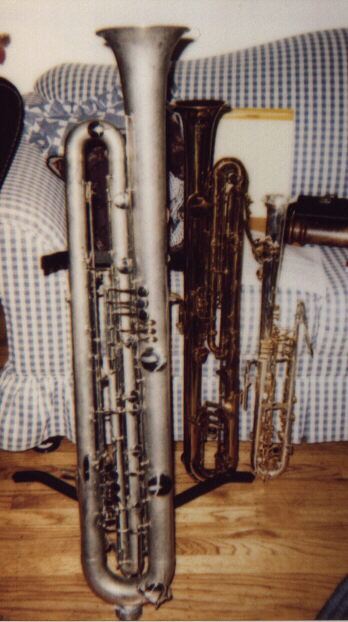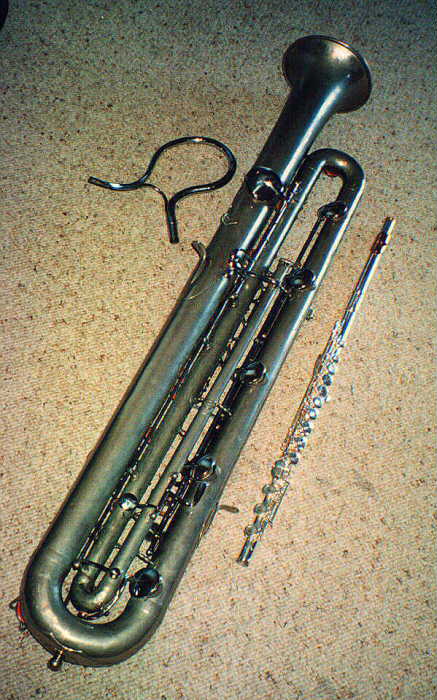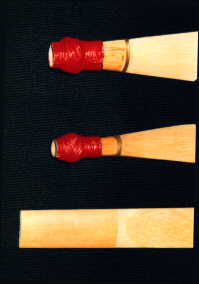The Instrument:The Sarrusophone was invented in the mid 1800's by Gautrot to compete with the Saxophone, for use in military bands to bolster or replace oboes and bassoons. The instrument was named after the French bandmaster Sarrus, who Gautrot credited with the idea for the instrument. Both names appear on the original French patent (French patent #28034, 1856). It was available in all sizes from Eb sopranino to BBb contrabass, including contrabasses in Eb, C, and Bb. The Eb appears to be the most common contrabass sarrusophone (if not the most common sarrusophone of any size), while the C contrabass appears to have been intended as a substitute for the contrabassoon (which was much less satisfactory in the mid-1800's). C.G. Conn at one time sold contrabass sarrusophones in EEb (model 16V) as a substitute for the EEb contrabass sax, after winning a contract to produce 148 Eb contras in 1921 for the US military). I can see why: the EEb contrabass sarrusophone weighs less than a baritone sax (at least, my Gautrot contra seems to weigh less than my Selmer bari), and must be much less than a contrabass sax. They must have been much more economical and practical (especially if you were going to have to carry it any considerable distance).There is a substantial difference in timbre between contrabass sarrusophones of different brands: some, such as the Gautrot pictured here (on the left), are large bore instruments (aka "big pipe"), while others, such as Conn and Buffet, are narrower bore (aka "small pipe"). The large bore instruments have a mellower sound, somewhat closer to a contrabass sax, while the narrow bore instruments sound really reedy. |

|
| Imagine a metal oboe, or a narrow
soprano
sax with a double reed and you'll have a good idea of the soprano sarrusophone.
The soprano sarrusophone is straight: all lower sarrusophones have at
least one bend, and are configured so that the bell points upward (as
on a bassoon). There is apparently a Buffet Bb soprano
sarrusophone at the Dayton C. Miller
collection at the Library of Congress (United States). Alto
and tenor sarrusophones have only one bend, thus resembling a metal
bassoon in form, if not appearance. The baritone and bass have
another pair of bends (always an odd number, so that the bell ends up
at the top), while the contras have still another pair.
The sarrusophones have keywork much like a saxophone, with a few differences. In fact, the sarrusophone is so similar to the saxophone that A. Sax sued the sarrusophone makers for patent infringement. Repeatedly. You will find many fewer keys and alternate fingerings on the sarrusophone than on the modern saxophone, probably because development of the sarrusophone stopped many years ago, while the saxophone continues to be improved today. For example, the sarrusophone does not have an automatic octave key, but rather has 2-3 separate octave keys. Although this can make for some awkward switches, it also permits one to play into the altissimo register, despite the lack of "palm keys" found on the saxophone. There is no alternate fingering for Bb, no fork key for F#, no articulated G# or C#, and the low Bb is operated with the left thumb. (Of course, the saxophones of that time didn't have a low Bb, and also lacked automatic octave keys and articulated G#s: keywork generally ranged from low B to high Eb or E.) There is a full fingering chart for the sarrusophone at the IDRS site, and at the online Woodwind Fingering Guide. |
The sarrusophones I have (pictured above)
are: Bb tenor
(by ORSI), Bb bass (by Triebert) and EEb contrabass (by Gautrot). The
bass and contra were built around 1920 (give or take a decade), and are
now in completely playable condition. The tenor was made
recently. The Bb bass came with a single-reed mouthpiece, which
resembles an alto sax mouthpiece (and takes alto sax reeds) that ends
in a blank wall, having only a small hole for the bocal. The chamber
inside appears to have been specially carved for this application.
With the single- reed mouthpiece, the instrument sound a lot
like
a saxophone: sort of like a bari sax transposed down a fifth. It can
also
be played with a double reed. It takes a reed somewhat larger than a
bassoon
reed (in all dimensions), but I've found that bass sordune reeds seem
to
work pretty well.
The EEb contrabass takes the largest double reed I can find: a great bass sordune reed (which is quite a bit larger than my sole remaining contrabassoon reed). It produces a quite satisfying rumble, reaching an octave below the baritone sax (second Db below the bass clef), and capable of belting out the sound. The image below shows the beast next to a regular concert flute (for scale). The image to the right shows my contra reed, a contrabassoon reed, and a bari sax reed for scale. I've since found that Keith Loraine makes sarrusophone reeds at a reasonable price. |
 |
 |
The Repertoire:The sarrusophone is still used sometimes in France and Italy for the contrabass reed parts. Several composers have written parts specifically for the sarrusophone(s):
|
The Sound:Here's a clip (WAV 948K, mp3) and a RealAudio file of me playing a (narrow bore) Evette & Schaeffer EEb contra. The E&S contra is somewhat longer than the Gautrot (although apparently at the same pitch - just folded slightly differently), and takes a narrower bore bocal and reed. It strikes me as much quieter than the Gautrot, but that may just be the reeds I've been using (bass sordune for the E&S contra, great bass sordune for the Gautrot, both obtained from the Early Music Shop). Also, here are a few RealAudio files of the bass sarrusophone (file 1) (file 2).Finally, here's a RealAudio clip of a recent San Jose Wind Symphony concert. On "Russian Sailor's Dance", the bass sarrusophone (playing the bass sax part) is audible in unison with tubas, bass clarinets, bassoons and bari sax. |
Recordings:You can hear sarrusophones on CD in Paul Winter's " Callings " and " Icarus ". On Icarus, you can hear it mainly playing pedal tones. On "Callings", two contrabass sarrusophones (Eb and C) play in imitation of blue whales (RealAudio or WAV file)(mp3). The clip is from Blues' Cathedral, and contains about 12 seconds of a contrabass sarrusophone playing "call and answer" with a blue whale (which I've edited out), in 8-bit mono at 11 kHz. The CD is LD0001 on Living Music, and is highly recommended. Other recordings are listed in the Discography. |
There is also a famous jazz recording of Sidney Bechet (more famous for his clarinet and soprano sax work) playing a sarrusophone on the song "Mandy, Make Up Your Mind" with the Clarence Williams Blue Five. He plays it during the introduction, and takes the first solo after the vocal (by Eva Taylor), continuing beneath the trombone solo that follows. It is also prominent in the last few notes of the piece. There is some disagreement as to whether the horn is a bass or contrabass sarrusophone (I've even seen one report that it was a tenor - clearly incorrect!). Listen to the clip, and tell me what you think. The bass sarrusophone the range of the bass sax, and the EEb contrabass sarrusophone has the range of the contrabass sax. The current consensus is that the horn is an EEb contrabass. I have it on good authority that SB's solo goes as low as Eb (second octave below the bass clef), which would make his instrument almost certainly the Eb contra. Here's a short excerpt (about 22.5 seconds) from the beginning of his solo in RealAudio or WAV (~239 K)(mp3). The piece has been rereleased on the CD "Sidney Bechet", on the Flapper label (PAST CD 9772, Pavilion Records, Ltd., Sparrows Green, Wadhurst, E. Sussex, England), which is a disc well worth while for fans of pre-bebop jazz. It's also available on "Jazz Classics in Digital Stereo: Sidney Bechet" (ABC Records 838 032-2). I should mention that the other players are Louis Armstrong on cornet, Charlie Irvis on trombone, Clarence Williams on piano, and Buddy Christian on banjo. |
Want to join a sarrusophone quartet?It turns out that Keith Loraine owns and plays both Eb contrabass sarrusophone and Eb baritone sarrusophone (the "combat bassoon"). With Bb tenor and Bb bass sarrusophones, we can cover all the parts of a SATB saxophone quartet |
Want a sarrusophone of your own?I have the bizzare idea that there may be a demand for new sarrusophones. There are instrument makers around that might be interested in making a sarrusophone or two, especially if they know that they can use the tooling to make several instruments. Therefore, I am conducting an unofficial, highly inaccurate market survey. If you would like to express your interest in having a new sarrusophone, send an email to me with the statement that you'd like a sarrusophone, what size, and how seriously you would actually consider it. I now have a list established for notifying anyone interested in sarrusophones whenever I spot one for sale. I will tabulate the results and post them here. If events warrant, I'll see if I can find a maker interested enough to make a small quantity of sarrusophones to order, and how much it would cost. Personally, I'd like a CC or BBb contrabass with an articulated G#, fork Bb fingering, and semi-automatic octave keys.If you are an instrument maker, let me know if you might be interested in such a venture. I have Bb tenor, Bb bass, and Eb contrabass instruments that could serve as templates This is not an offer to sell or buy, and your statements will not be considered offers to buy or sell. At this point, this is only market research. Sarrusophones also appear for sale sometimes on eBay. Whenever I run across a sarrusophone for sale, I generally announce it on the contrabass list, a separate "sarrusophone4sale" list, and the sarrusophone club and group listed below. Let me know if you'd like to receive any of these lists. |
| Discography Back to Home Copyright ©1995-02 by Grant D. Green
|
More Info:Join the Sarrusophone Club at Yahoo!Join the Sarrusophone Group at Yahoo! (formerly eGroups) Join the Contrabass list |
